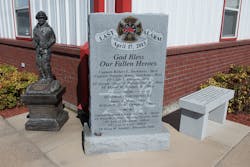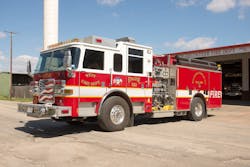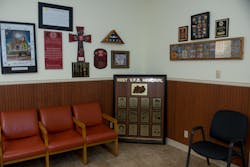Five Years Later: Progress Borne from TX Explosion
It’s been five years since an explosion devastated the small town of West, TX, where 13 people, including 10 local first responders, died.
On April 17, 2013, the day “West shook,” five of those who perished were with the West Volunteer Fire Department (WVFD).
In the weeks following the incident, the department was inundated with people making suggestions, offering assistance, or questioning what happened.
“They had somebody breathing on them constantly, every day,” West Fire Marshal Harold Pfleiderer told Firehouse.com.
Pfleiderer, a career firefighter, was hired as the city’s fire marshal in 2015. His duties include fire prevention and inspection and helping the department grow.
Following the fire and deadly blast, which ATF investigators labeled an incendiary, criminal act in 2016, the department and its response was reviewed by several panels, including NIOSH and the Texas State Fire Marshal’s Office. They looked at everything from equipment and the response, to training and preparedness.
“The West Fire Department is going to be a case study for the next 20 years. This isn’t going away,” Pfleiderer said. “People are going to be looking at us and scrutinizing us…and instead of being offended by it, we need to embrace it and grow from it.”
Pfleiderer said the first thing he did was take the recommendations from the Texas State Fire Marshal’s in-depth report and turn them into his “bible to guide me through the priorities to move us in a direction to get in a better place.” The 55-page report included 11 recommendations for the department and city to act on.
“Out of those 11, I can say confidently, that we have nine of the 11 well underway,” he said. “The remaining two, we’re at some level, but probably not where we need to be.”
Here’s a look at how West has implemented those recommendations:
- The department implemented standard operating guidelines for all areas of operations.
- The department has retooled their strategies and tactics to include alternative attack plans.
- The fire marshal/emergency manager offices have instituted a risk management program.
- The department has created preplans for all target-hazard locations within the city.
- The city adopted the 2015 International Fire Codes.
- The fire marshal’s office created new fire and safety outreach programs.
- The department has on-going incident management training and implemented an Incident Command System, including a formal accountability process. Incident safety officer training was also conducted.
- The department has increased the number of hours required and raised the degree of training.
- The city implemented a policy that prohibits firefighters from taking part in activities if they’ve consumed alcohol or drugs.
- The department increased their hazardous materials training and preparations.
Today’s firefighters
In 2013, the department’s roster included 27 members and today it shows 29 members, with 25 being active firefighters and four holding various support roles. Fifteen people who were on the department on April 17, 2013, remain on the roster today.
“Immediately following the explosion, they needed to backfill the ranks and it was a big enough deal that the local paper ran a story,” Pfleiderer said. “That added five to the roster.”
Three of the firefighters added to the roster since 2013 are career firefighters in other communities, including Pfleiderer, and have helped increase the department’s response capabilities, including providing training or having specialty training.
“Now we have a member who is trained as a hazmat incident commander, we’ve got two hazmat technicians and a fire investigator/inspector,” Pfleiderer said.
Training
The bulk of the fire department’s responses—they had 166 calls in 2017—are to vehicle crashes and fires on Interstate 35, where close to 90,000 vehicles pass through the city daily.
Several changes have improved the depth and level of training that West firefighters now receive. It’s not uncommon for firefighters to travel to regional, state or national training conferences over the last few years.
The three career firefighters who have joined the department also brought their training instructor skills, which allows for West firefighters to receive accredited or certified training—something they didn’t have before.
“So that gives us a better ability to train and get credit for it,” Pfleiderer said, adding that it is one of the two areas where the department is continuing to make significant improvements is their training on strategy and tactics.
“I think all fire departments struggle to keep their strategies and tactics current, but we also struggle with so few calls that it’s hard to use that training,” Pfleiderer said. “You can train, train, train, but if that days comes, will it be those firefighters who trained show up for the fire?”
The department is also in the process of completing a new set of standard operating procedures, which a committee is currently reviewing.
“Looking down the road two years from now…we are really focusing on training our guys,” Pfleiderer said.
Incident command and accountability
Part of the state fire marshal’s report from the explosion noted that there was little accountability or incident command in place when the 2013 explosion happened. That forced the department to evaluate their command-level training and implement several new practices.
All officers have completed National Incident Management System (NIMS) training and it is applied on routine calls so all members are familiar with it.
Accountability tags are now carried by all firefighters and left with commanders at emergency scenes, so a formal accountability process has been put in place.
Firefighters took part in risk management training to help all ranks understand the risks associated with different emergencies, and it now applied to the various responses made by West firefighters.
Community risk reduction
Firefighters, city officials, residents and property owners have all been a part of the changes brought by the report when it involves community risk reduction.
Pfleiderer said that the other struggle for the city, based on the state fire marshal’s report, involves implementing building codes.
The city adopted the 2012 International Building Code to help improve fire safety throughout the city and it provides guidelines for building construction and systems, including fire and life safety.
Pfleiderer has been able to get new buildings up to code, but has encountered challenges when it comes to retrofitting existing structures.
“It would be very costly to get existing businesses to upgrade,” he said, noting the costs that could impact the many small businesses that line the city’s streets.
As a result of the report, the city adopted the International Fire Code’s hazard materials code, found in Chapter 50.
That has played a vital role in helping local businesses understand their role in safeguarding their materials storage, which can be found at several smaller-scale hazmat facilities. The adjacent community has a large fertilizer storage facility.
Interstate 35 has myriad hazardous cargo passing through the city daily, as well as a thousands of railcars carrying a variety of hazardous materials on the main railroad line that runs through the center of town.
Pfleiderer said each of those possess challenges, but the training and records help keep West responders informed and prepared.
The career firefighters serve as hazmat technicians at their respective departments, and that’s allowed the WVFD to have additional resources on hand. With preplanning and added training, all members have access to the hazardous materials data for emergency responses.
In the last few years, the department changed its approach to fire prevention.
“We would go to the school during fire prevention week and let the kids see the fire trucks,” Pfleiderer said. “Now they get an actual fire prevention program with an education portion to it.” He added that an educated public not only helps raise the community’s awareness levels, but also increases the safety for everyone.
Gathering building intelligence has been a big success for the fire department, based on the report’s recommendation to create pre-incident plans.
The department has created plans for commercial and target-hazard structures, detailing layouts, on-site hazards, fire protection systems and alerts to warn firefighters of any unusual dangers or situations they may encounter.
They are carried on all apparatus in binders and accessible on the station’s computer. As funding becomes available, the goal is to create digital preplans, he said.
Apparatus
The explosion destroyed half of the department’s apparatus, including a brush truck, pumper and tanker. Shortly after the explosion, Texas’ Pierce dealer, Siddons-Martin Emergency Group, donated a used pumper and brand new tanker to help the WVFD get back on their feet. Two others that were donated were given to local departments because they were not needed. Tender 31 is a Pierce Contender DX with a 3,000-gallon tank.
The department planned to use the insurance money received for the damaged apparatus to purchase a new custom pumper, but opted to buy two used pumpers for the same price, plus equip the rigs.
Engines 311 and 312 are identical 2006 Pierce Arrow XT pumpers. They have 1,500-gpm pumps, 1,000-gallon water tanks, plus foam systems. Engine 311 also carries a full complement of extrication and rescue tools.
WVFD also received a partial donation of a brush truck (Brush 311) and a command unit (Command 31) was purchased with funds donated to the department.
Other donations that were received, but were not needed, were given to the school district.
The pumper that was donated to West by Siddons-Martin was then donated to the nearby City of Gholson, becoming its first pumper. Prior to the donation, that department only had brush units and tankers.
“It’s continuing to live its life as a fire apparatus in an even smaller rural town than our town.
The pumper that survived the explosion was sold to a nearby community.
Each apparatus in the fleet includes a memorial to the first responders killed in the explosion.
Memorials
Five years later, Pfleiderer said it’s not uncommon for someone to stop by the fire station each day to visit and see the memorials or talk about the explosion.
The interior and exterior of the station are adorned with memorials to the April 17 blast and the loss of the firefighters and first responders. Located on the southwest corner of the one-story fire station is a memorial, a cross and a bench. In the station’s meeting and training room are several memorials that include firefighter photos.
Work is well underway for a permanent memorial adjacent to the site of the explosion on Stillmeadow Drive. The memorial, which is designed similar to the National Fallen Firefighters Memorial in Emmitsburg, MD, includes busts of all 13 who perished.
Looking forward
Pfleiderer reflected on a class he attended by Dr. David Griffin, who spoke about the Charleston, SC, Fire Department’s recovery from the 2007 Super Sofa Store fire that claimed the lives of nine firefighters.
“He said it takes years to tear down those walls that come with change,” Pfleiderer said. “You can tell every day that the walls are coming down. I see all of the things that he mentioned happening as we come up to year five.”
“I’m excited where we are at year five and it’ll be better at year seven,” he said. “I’m interested to see, very interested to see where we will be at year seven.”
West is growing. New housing developments and a major apartment complex are on the drawing board and Pfleiderer said the five years of work since 2013 are showing.
Codes are being included with the new structures and one resident asked the West fire marshal’s office if they were allowed to place fire sprinklers in their home.
As the city expands, the department plans to expand their station.
“We are better prepared for the daily challenges,” Pfleiderer said. “We are better equipped, both equipment wise and education wise.”
First responders lost
- Morris Bridges – Firefighter, West Volunteer Fire Department
- Perry Calvin – Firefighter, Mertens and Mills volunteer fire departments and a member of West EMS
- Jerry Chapman – Firefighter, Abbott Volunteer Fire Department and a member of West EMS
- Cody Dragoo – Firefighter, West Volunteer Fire Department
- Kenneth Harris – Captain, Dallas Fire-Rescue, who was off-duty but responded to help
- Jimmy Matus – Sales Manager, Westex Welding & Fire Apparatus. Named Honorary Firefighter, West Fire Department
- Joseph Pustejovsky – Firefighter, West Volunteer Fire Department
- Cyrus Reed – Firefighter, Abbott Volunteer Fire Department and a member of West EMS
- Kevin Sanders – Firefighter, Bruceville-Eddy Volunteer Fire Department and a member of West EMS
- Doug Snokhous – Captain, West Volunteer Fire Department
- Robert Snokhous – Captain, West Volunteer Fire Department
- William “Buck” Uptmor – Owner, Uptmor Welding and Fencing, who responded to help livestock escape. Named Honorary Firefighter, West Fire Department


